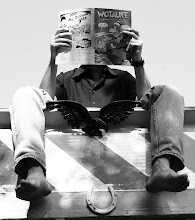 My mother, fourth from the left, in the white dress, accompanied by a group of her fellow artists, at a camp retreat in the early 50s. Note the Brownie camera held lovingly in her hand.
My mother, fourth from the left, in the white dress, accompanied by a group of her fellow artists, at a camp retreat in the early 50s. Note the Brownie camera held lovingly in her hand.Born in the south of England, on October 23rd, 1932, my mother, Phyllis Holland, was the only child of vegetable farmer named George Holland, one of four brothers who had each inherited a quarter of their father’s farm. Nicknamed Pudge, her father was a hard-working, kind-spirited man, who met, fell in love, and subsequently married an equally generous sole named Winifred (known as Winnie to her family and friends), a servant from a nearby manor house whose lineage was an open question, one leading to an unfolding of deep family secrets and the clandestine relationship between one of the heirs of the property and a member of the work staff.
Raised in a tiny cottage without running water or electricity, Phyllis soon found an inherent artistic inclination, one not in evidence in either of her parents. Nevertheless, she was encouraged to pursue this interest and was soon excelling at art in school, eventually going on to attended the Kingston School of Art in London, where she again excelled, especially in drawing and painting classes. Upon graduating, she went to work in the design department of a local ceramics pottery and proceeded to build a resume of her illustration work, selling card designs to Gordon Fraser, the top greeting card company in Britain, as well as living the life of a young artist in the early 1950s, experiencing the burgeoning bohemia of that pivotal period of European culture. It was during this time that she met my father, David Eaton, while on a cycling tour. The two were married soon after and, in an efficient manner, produced four children, the third of which was I.
Sadly, Phyllis found being a mother and keeper of the family’s domain left precious little time for her artistic pursuits. Throughout the years, my older sister and I (also blessed with the “art gene”) have attempted to resurrect this latent talent, offering regular enticements in the gift of art supplies, but the resistance is always strong, such a prolonged absence creating little confidence. Of course, every sketch I have managed to eek from my mother’s hand, over the years, has been a treasure worth keeping. I will showcase some of these later period works in a future post, for now I’d like to introduce artist, Phyllis Holland, by way of some of her earliest student sketchbooks, a series of drawings done from life, of her family (and a poor bird), at work and rest, about the old farm house, as well as a couple of illuminating photographs. I hope you enjoy.
My mother, as a baby, with her parents, Winifred and George, 1933.
Finally, here’s my mother, in 1951, as a student at the Kingston School of Art, being costumed for a New Year’s Eve party. This photo was published in the Sunday Graphic newspaper. The amusing caption read: Wouldn’t Father Neptune be proud of this attractive young daughter of the deep? Wouldn’t anyone – even a fishmonger – be happy to make a catch like this? But Phyllis Holland is a mermaid for one night only – New Year’s Eve. In her salty sea-suit she will join other students of Kingston School of Art in their tableau at the Chelsea Arts Ball.







































